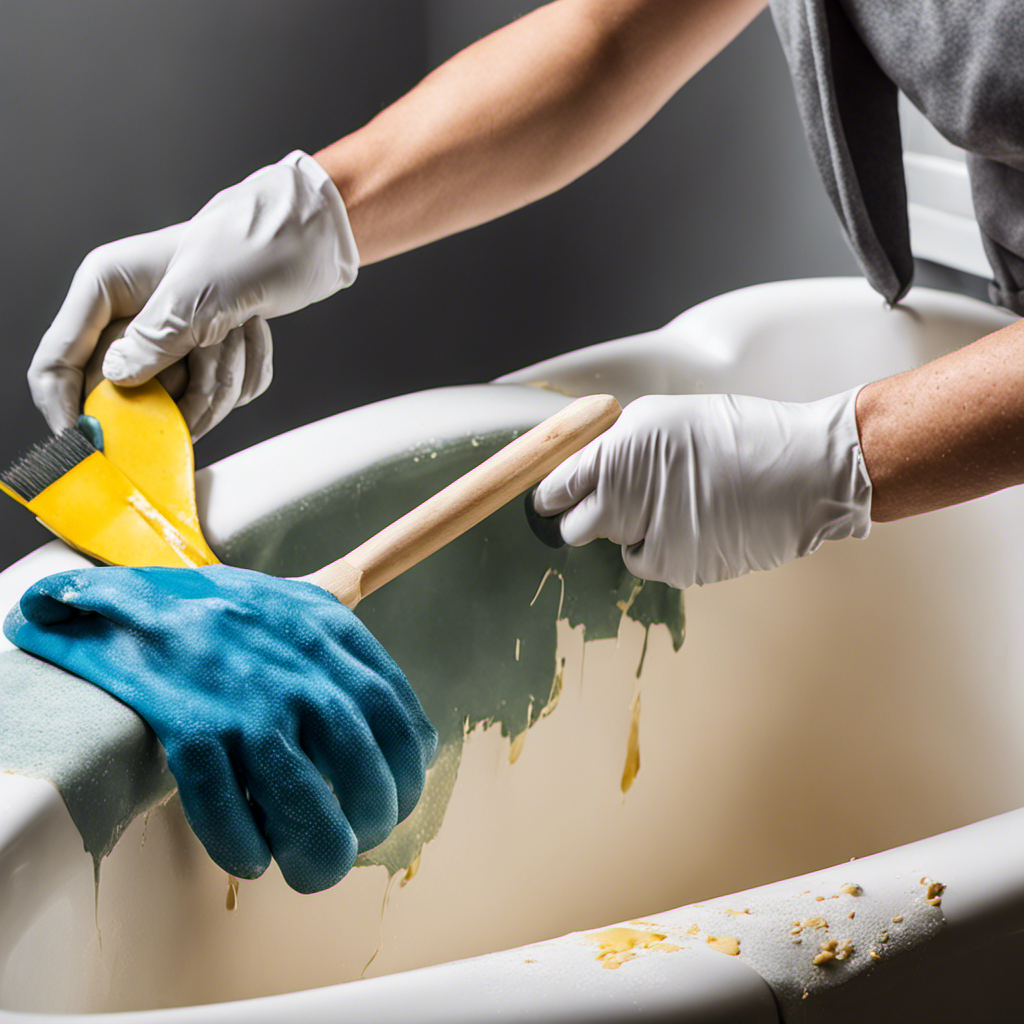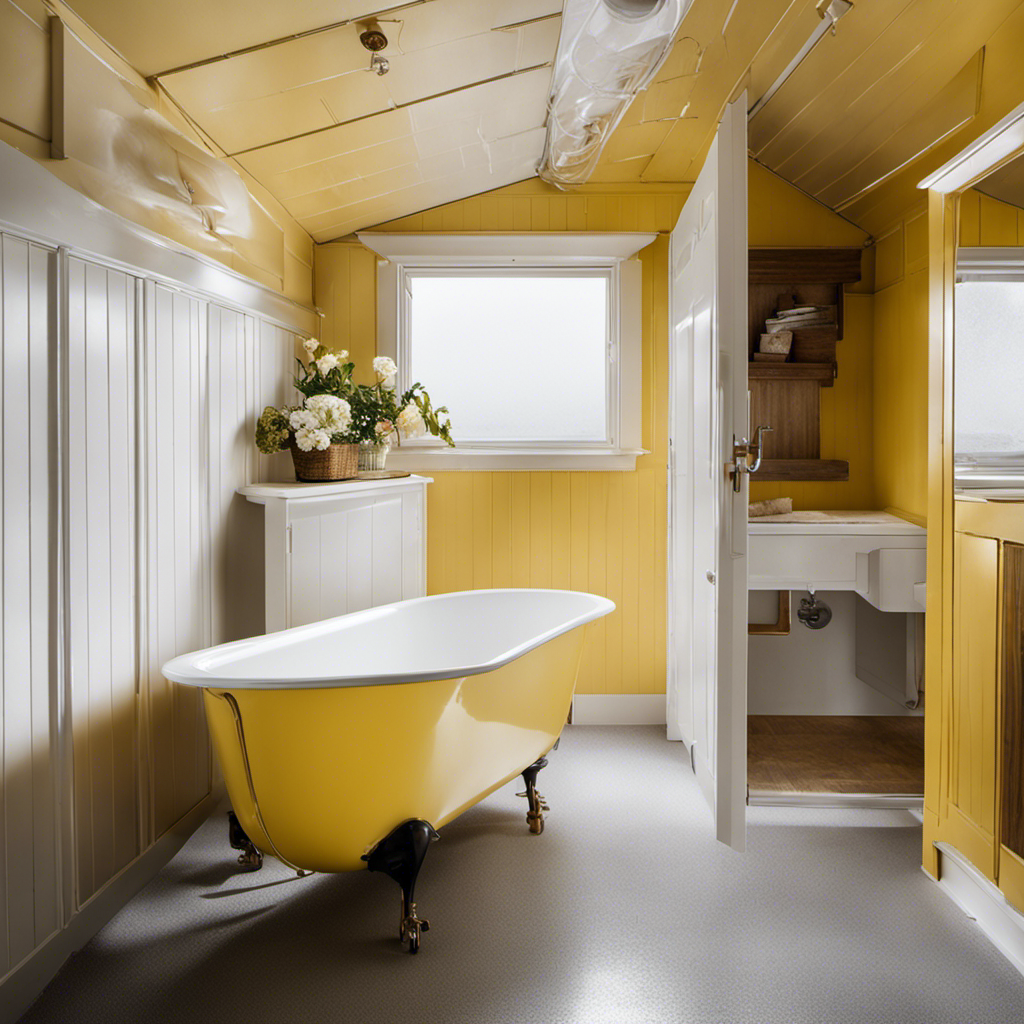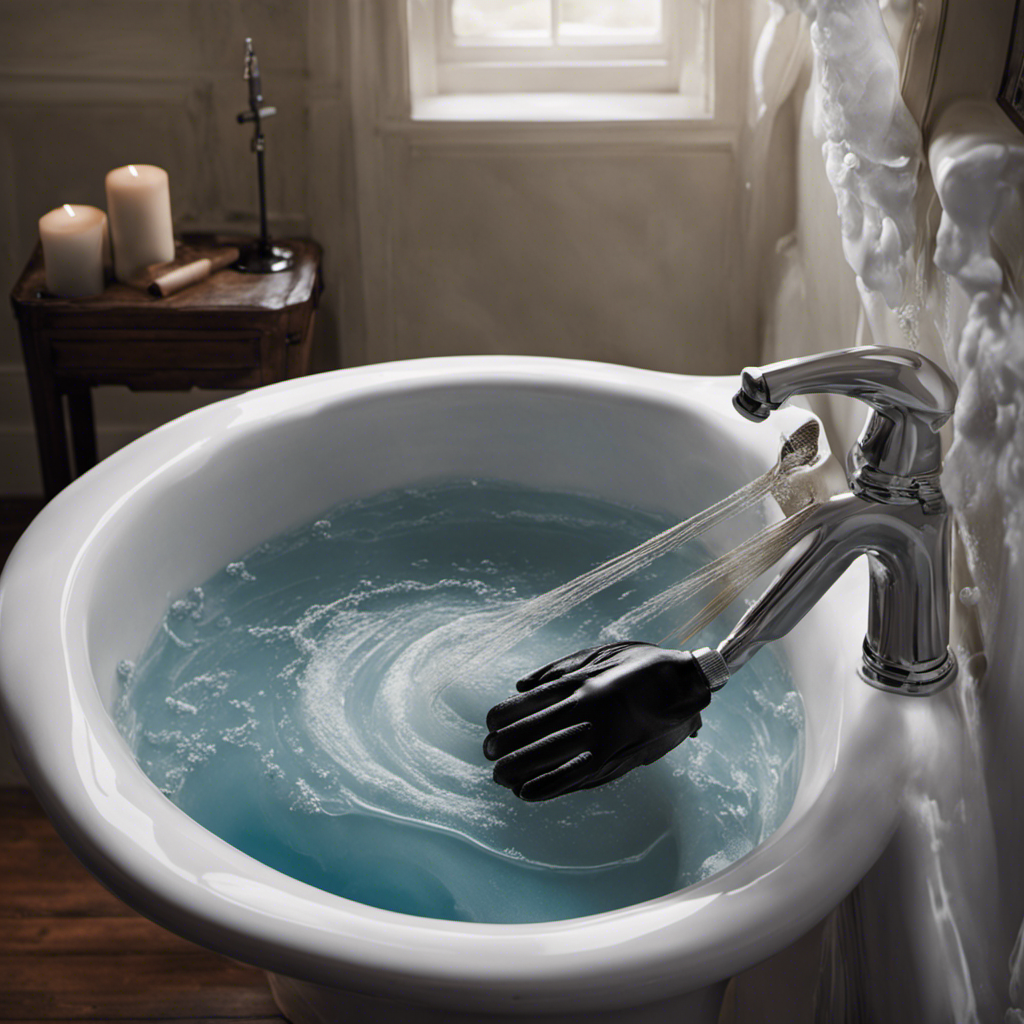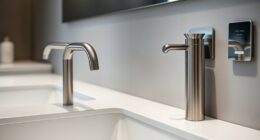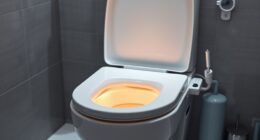As a seasoned DIY enthusiast, I’ve encountered my fair share of home improvement challenges. One of the most frustrating issues I’ve faced is peeling bathtub paint. But fear not, because I’m here to share my tried and true method for removing that stubborn paint.
In this informative guide, I’ll walk you through the steps to assess the extent of the peeling, gather the necessary tools and materials, and prepare the bathtub for paint removal. With my detailed instructions, you’ll have a clean, smooth surface ready for a fresh coat of paint in no time.
Key Takeaways
- Thoroughly examine the bathtub surface for peeling or chipping paint.
- Determine if the peeling is limited to a small section or if it is widespread.
- Identify the potential causes of peeling paint, such as moisture or improper surface preparation.
- Use the assessment to determine the appropriate steps for removing the peeling paint.
Assess the Extent of the Peeling Paint
First, you’ll need to assess the extent of the peeling paint to determine the best course of action. Start by thoroughly examining the bathtub surface to assess the damage. Look for areas where the paint is peeling or chipping away. Is the peeling limited to a small section or is it widespread? This assessment will help you determine the appropriate steps to take in removing the peeling paint.
There are several potential causes for peeling paint on a bathtub. It could be due to moisture, improper surface preparation, or the use of low-quality paint. By identifying the cause, you can prevent future peeling and ensure a successful paint removal process.
Once you have assessed the damage and determined the cause of the peeling paint, you can move on to the next step: gathering the necessary tools and materials.
Gather the Necessary Tools and Materials
Before you begin, make sure you have all the tools and materials you need for the job.
Removing peeling bathtub paint requires the right equipment to ensure a successful and efficient process.
Firstly, you will need a paint scraper or putty knife to gently scrape off the peeling paint.
Additionally, it is essential to have a sanding block or sandpaper to smooth out any rough edges or remaining paint.
To protect yourself, wear safety goggles and a dust mask to prevent any particles from getting into your eyes or lungs.
As for the materials, consider using a primer and paint specifically designed for bathtubs.
There are several reputable bathtub paint brands available, such as Rust-Oleum and Homax.
However, if you prefer alternatives, epoxy or enamel-based paints can also be suitable options.
Remember to follow the instructions provided by the manufacturer for the best results.
Prepare the Bathtub Surface for Paint Removal
To get started, you’ll want to ensure the bathtub surface is properly prepared for the paint removal process. This step is crucial in achieving a successful bathtub refinishing. Professional paint stripping can be a great option if you want a flawless finish. Here are some key steps to prepare your bathtub surface:
| Steps | Description |
|---|---|
| Step 1 | Clean the bathtub surface thoroughly using a mild cleaning agent and a non-abrasive sponge. Rinse it well and let it dry completely. |
| Step 2 | Use a fine-grit sandpaper to lightly sand the entire bathtub surface. This will help remove any loose or flaking paint. |
| Step 3 | Fill any cracks or chips in the bathtub surface with a bathtub repair kit, following the manufacturer’s instructions. Allow it to dry and sand it smooth. |
| Step 4 | Apply a primer specifically designed for bathtubs to ensure proper adhesion of the new paint. Let it dry according to the manufacturer’s instructions. |
| Step 5 | Finally, use a tack cloth to remove any dust or debris from the surface before proceeding with the paint removal process. |
Choose the Appropriate Paint Removal Method
Once you have prepared the bathtub surface, you can choose the most suitable method to remove the paint.
When it comes to removing paint from a bathtub, you have two main options: chemical or mechanical methods.
Chemical methods involve using paint strippers or solvents to dissolve the paint. These products usually come in liquid or gel form and are applied directly to the painted surface. It is important to follow the manufacturer’s instructions and wear gloves, goggles, and a mask for safety.
Mechanical methods, on the other hand, involve using physical force to scrape or sand off the paint. This can be done using a scraper, sandpaper, or a power sander.
Whichever method you choose, it is crucial to take the necessary safety precautions and work in a well-ventilated area to avoid inhaling fumes or dust particles.
Apply the Chosen Paint Removal Method
When it comes to removing paint, there are two main methods to consider: chemical or sanding.
Chemical paint removal involves using solvents or paint strippers to dissolve the paint and make it easier to remove.
Sanding, on the other hand, involves using sandpaper or a sanding machine to physically remove the paint by abrasion.
Both methods have their advantages and disadvantages, so it’s important to choose the one that best suits your needs and the condition of the painted surface.
Additionally, when it comes to selecting the best products for paint removal, factors such as the type of paint, the surface material, and personal preferences should be taken into account.
Chemical or Sanding
If you want to remove peeling bathtub paint, you can use either a chemical stripper or sanding.
When it comes to chemical safety, it is essential to wear protective gloves, safety glasses, and a mask to avoid any potential harm. Chemical strippers contain strong solvents, so it’s crucial to work in a well-ventilated area to prevent inhalation of fumes.
Follow the instructions on the product carefully and apply the stripper evenly onto the painted surface. Allow it to sit for the recommended time, and then use a scraper to remove the softened paint.
Sanding, on the other hand, requires patience and the right technique. Start with a coarse-grit sandpaper to remove the peeling paint, then switch to a finer grit for a smoother finish. Remember to sand in the direction of the grain and avoid applying too much pressure, as it may damage the bathtub’s surface.
Best Products for Removal?
To effectively tackle this task, you’ll want to consider using a chemical stripper or sanding for the best results. However, when it comes to choosing the best chemical removers for peeling bathtub paint, there are a few options that can make the process easier and more effective.
Here are some of the top chemical removers that I recommend:
| Chemical Remover | Benefits |
|---|---|
| CitriStrip | Effective on multiple layers of paint; non-toxic and biodegradable. |
| Dumond Smart Strip | Removes multiple layers of paint with minimal effort; safe for indoor use. |
These chemical removers are great alternatives to sanding because they work by breaking down the paint, making it easier to remove without damaging the underlying surface. However, if you prefer to try alternative paint removal methods, there are a few options to consider:
- Heat gun: Applying heat to the peeling paint can soften it, making it easier to scrape off.
- Chemical-free paint removers: These removers use natural ingredients to break down the paint without the use of harsh chemicals.
- Mechanical methods: Using a scraper or sandpaper can manually remove the peeling paint.
Remove the Loosened Paint From the Bathtub
You can easily remove the loosened paint from the bathtub by gently scraping it off with a putty knife. Start by examining the peeling areas to identify the extent of the damage.
If the paint is only slightly loose, it may be possible to remove it without damaging the underlying surface. However, if the paint is severely peeling or bubbling, it may be necessary to remove all of the loose paint and repaint the bathtub.
To remove the loosened paint, hold the putty knife at a slight angle and carefully scrape it along the surface. Be sure to work slowly and avoid applying too much pressure, as this could cause further damage.
Once the loose paint has been removed, clean the area thoroughly before applying any new paint.
Clean and Prepare the Bathtub for Repainting
When it comes to repainting a bathtub, proper preparation is essential for a successful and long-lasting finish. In order to achieve this, two key points to focus on are surface cleaning techniques and proper paint application.
Firstly, thorough cleaning is crucial to remove any dirt, grime, or soap scum that can prevent the paint from adhering properly.
Secondly, applying the paint correctly, using the right tools and techniques, ensures an even and smooth finish that will withstand the test of time.
Surface Cleaning Techniques
Start by wiping down the bathtub surface with a mixture of vinegar and water. This simple cleaning solution is effective in removing dirt, grime, and soap scum from the bathtub.
Here are some alternative methods you can try to achieve a sparkling clean surface:
-
Baking Soda Paste: Mix baking soda with a small amount of water to create a paste. Apply the paste to the surface and scrub gently with a sponge or brush. Rinse thoroughly.
-
Lemon Juice: Cut a lemon in half and sprinkle salt on the cut side. Use the lemon as a scrubber and rub it on the bathtub surface. The acidity of the lemon juice helps to remove stains and leave a fresh scent.
-
Hydrogen Peroxide: Mix equal parts hydrogen peroxide and water in a spray bottle. Spray the solution onto the surface and let it sit for a few minutes. Scrub with a brush or sponge and rinse well.
-
Dish Soap: Fill a bucket with warm water and add a few drops of dish soap. Dip a sponge or cloth into the soapy water and scrub the bathtub surface. Rinse thoroughly to remove any residue.
These alternative cleaning methods can be just as effective as commercial cleaning products, and they are often more environmentally friendly. Experiment with these solutions to find the one that works best for you.
Proper Paint Application
For a smooth and even finish, it’s important to apply the paint in thin layers, using a brush or roller. Proper paint preparation is crucial before starting any painting project. This includes cleaning the surface, removing any loose or flaking paint, and repairing any cracks or holes. Once the surface is properly prepared, you can begin the paint application process. One common mistake is applying too much paint at once, leading to drips and uneven coverage. Another mistake is not allowing sufficient drying time between coats, which can result in an uneven finish. It’s also important to pay attention to the direction of the brush strokes or roller movements to ensure a consistent look. By following these tips and avoiding these common mistakes, you can achieve a professional-looking paint job.
| Common Paint Application Mistakes | How to Avoid Them |
|---|---|
| Applying too much paint at once | Apply thin layers and build up coverage gradually |
| Not allowing sufficient drying time between coats | Follow the recommended drying time on the paint can |
| Ignoring the direction of brush strokes or roller movements | Work in one direction for a consistent finish |
| Using a low-quality brush or roller | Invest in good quality tools for a better application |
Conclusion
In conclusion, tackling the task of removing peeling bathtub paint may seem daunting, but with the right tools and method, it can be a manageable project.
By carefully assessing the extent of the peeling paint and preparing the surface properly, you can effectively remove the unsightly paint.
Remember to choose the appropriate paint removal method and take your time to ensure the best results.
Once the paint is removed, give your bathtub a thorough cleaning and prepare it for a fresh coat of paint.
Your bathtub will be rejuvenated and ready for many relaxing baths to come.
